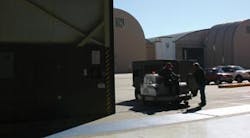The ground support crew at Robins Air Force Base has found it a bit easier recently to haul equipment in the tight quarters of hangars and around airplanes, due to a technology that was originally shelved after 9/11. Re-emerging nearly five years later, the Omni Directional Vehicle has aimed at carving a niche for itself in military GSE.
A New Direction
The Omni Directional Vehicle, developed and patented by Hammonds Technical Services Inc., made its ground support introduction at Robins Air Force base in Georgia in 2005. A circular vehicle, the technology has presented itself as an easier way to manipulate bulky equipment on the ground.
The first of its kind, the vehicle was designed as a tractor to pull heavy loads, but meant to rival the conventional. Maneuverability was a key ingredient in the design, with its ability to turn 360 degrees with a zero-turn radius.
The ODV’s ability to maneuver proved a main selling point for the AFB. As the first and only base to have implemented the machine with traditional tugs, ground workers have witnessed an operational advantage first hand. “It helps maneuver around in tight places tremendously,” Dwayne Markham says, a hydraulic technician at the base. “You don’t have to have somebody wait for you. We would have somebody help you hook up the old tractor. You couldn’t get out there and do it yourself.”
In addition to a modest turn radius, a rotary hitch was designed to run the circumference of the vehicle. A Pintle connection was added to lock in the front or the rear. With the body left free to swivel, the ODV has made switching operations more efficient at the base. “If you are in situations where you need to pull something instead of push … you can pull the lever on it and spin it around 180 degrees, and then you are pulling instead of pushing,” Markham says.
Since it was conceptualized in 2001, the ODV has evolved into a series of four models — G18, G30, G60 and G90 — each available with diesel, electric, propane and gas engines.
Correlating with the total towing capacity, the G90 can tug up to 90,000 pounds. The AFB currently has nine G30 units. Though the ODV is not being used for towing aircraft at Robins, the base has found multiple uses for it. “We mostly tow GPUs, electric generators, power generators, mobile air conditioners, heavy trailers, transport door on dollies,” Markham says.” The ODV has helped us tremendously. Where we can only take one at a time, we can take at least two at a time now.”
Built as a tractor for heavy loads, with add-ons the ODV can be configured for a slew of separate ramp functions, including a snow plow, broom, lavatory truck and baggage truck.
Its basic design has made it an optimal multifunctional vehicle, according to Carl Hammonds, the innovator and founder of HTS. “It has a lot of applications, because it is a perfectly round vehicle,” Hammonds says.
In an industry that has emphasized speed and security, Markham says the ODV has helped get the job done. “You can do the task a lot faster and safer,” he says.
Safety Firsts
Along with versatility and efficiency, the ODV has presented additional safety features.
The center position of the user and the ability of the vehicle to turn freely mean users can always have a full view, without having to back up or look over his or her shoulder. “Because the operator is sitting in the precise center, he always has a relative position to see where he is going, what he is pushing against,” Hammonds says. “You have a very intuitive control, allowing you to precisely handle what you are pulling or pushing. When you are in a position where you can literally move in any direction, it just gives you a level of safety not only for personnel but for the equipment you are towing.”
The ODV also features a hydrostatic drive system — the engine driving only the hydraulic pump. A user must be actively utilizing the controls to move the machine. “If you are not operating the pump by moving the controls, that movement stops,” Dave Yuhasz says, president of Aerosafe Products Inc., the company that contracted the ODV with Robins AFB.
For its efficiency, versatility and safety features, the vehicle has been proclaimed a new technological paradigm. “It is a revolutionary piece of equipment,” Yuhasz says.
History in the making
The technology was several years in the making, having been derailed by a post-9/11 aviation industry.
It was developed and manufactured by HTS, a company that has specialized in fluid-powered additive injection systems.
Hammonds first developed and rolled the technology into a prototype in 2001, shortly before 9/11. In the aftermath, the aviation industry was not looking to buy new equipment for some time. “Airlines, FedEx, US Airways, Delta, were all on a panel and basically said, ‘Look guys, we appreciate your coming out to support us, but we won’t be buying equipment for at least another four to five years,’” Bob Dujon of Aerosafe says.
With an industry distracted and new equipment temporarily displaced, Hammonds decided to shelve the prospective aviation technology. In that time he developed a security vehicle and a snow plow. It was not until four years ago, when GSE was again being bought, that he was urged to fully develop the aviation prototype.
In 2005 two ODVs were rolled out onto the Robins Air Force Base, where the machines were implemented with traditional tugs. In 2006 the AFB ordered seven more.
The base has considered replacing the ODV with its traditional tugs in the coming years. “I think we are going to replace it,” Markham says. “It’s a lot more maneuverability … it will tug just as much as any tug we have out there. Robins is the only AFB it’s on right now. Each AFB operates independently, but they are hoping the others will follow their lead.”
Coming Full Circle
Aerosafe has kept a strong focus on the military sector of the aviation industry. With a US commercial market slow to react to new concepts, Aerosafe has hoped to infiltrate additional military branches, with testing to conclude on aircraft carriers.
Though it has taken some time for the ODV to make its way into the aviation industry, Hammonds has remained confident in its success. “As with any completely new concept, there is some resistance,” he says. “It’s so totally different than anything out there. If there is anything negative about the ODV, it’s that it seems too good to be true.”





